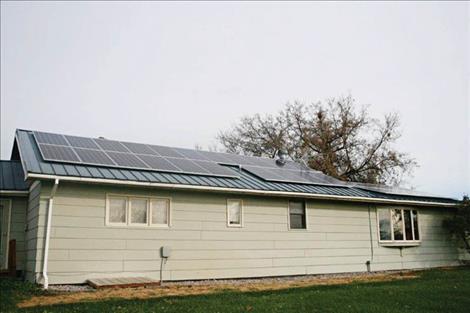‘True up’ periods cost solar power customers money
Hey savvy news reader! Thanks for choosing local.
You are now reading
1 of 3 free articles.
Green energy is the wave of the future, with more and more solar systems coming online every day.
But as new technologies have proliferated, policies haven’t always kept up, and lack of uniform energy policy across the country means that many solar power producers in Montana are losing banked energy they would be credited for elsewhere.
Rich Gebhardt installed a solar array in October 2018. The system is tied into the grid. It includes built-in safety measures including a special breaker.
“You have to be able to turn it off at any time,” Gebhardt said. “There are some extraordinary expenses that go into the array that Mission Valley Power requires.”
Gebhardt benefited from a process called net metering. Net metering allows people who generate more energy than used to receive a credit on their bill. In exchange, Gebhardt’s excess power enters the grid, and can be sold to other customers on the system. Gebhardt said Mission Valley Power told him around 50-60 customers participate in the solar program.
“In the summertime my experience has been that we generate a lot more than we use and in the winter time we use a lot more than we can generate,” Gebhardt said.
For two years Gebhardt generated energy and had a running banked energy credit.
In April 2021, all of his banked energy credit, approximately $350, disappeared on his bill. Gebhardt was told that Mission Valley Power has an annual “true up” period where in April of every year, the banked energy bill resets to zero.
“Nothing was ever said to me that they would have a true-up period, Gebhardt said. “There was nothing in their literature. I was not told anything either. There was no true up used with me in April 19 and April 20.”
Gebhardt said Mission Valley Power gave him copies of a policy that was adopted in 2005 saying that there would be an annual true up period. He said at that time he couldn’t find it on the company’s website, though it has since been updated there. He also says he kept copies of the documents signed for the power agreement, and they don’t match the ones Mission Valley Power provided him copies of from their files. He believes the files were altered.
Mission Valley Power’s General Manager Jean Matt said that the company is federally regulated and cannot comment on individual customer’s accounts. Upon more investigation, it appears that the true up period is not unique to Mission Valley Power.
“It is common that leftover credits are forfeited back to the utility without compensation to the solar owner,” Montana Renewable Energy Association Director Andrew Valainis said. “In some states, those credits can rollover for longer (e.g. 2 years) or they are rolled into another program, like an energy assistance program for low-income households.”
If Gebhardt lived in California, he would be compensated 2 to 4 cents per kilowatt hour at true up time, per state law. Over the past 40 years the Federal Energy Regulatory Commission has left the question of net metering, true ups, and compensation for solar energy producers to individual states and power producers.
“In Montana, yes there have been attempts in the past to find an alternative use for those banked credits rather than let the utilities simply absorb that value. In particular, rolling them into weatherization or low-income energy assistance programs,” Valainis said. “Unfortunately, those efforts at the legislature were not successful. It’s important to note that those legislative efforts would not have applied to Montana cooperatives, since they self-govern and are not subject to the net metering statutes we currently have in Montana. For changes to be made at a cooperative, the effort would need to be driven by cooperative members through the co-op board.”
The majority of the state’s rural population lives in areas where power is generated by electric cooperatives.
Because Mission Valley Power is federally owned and managed by the sovereign Confederated Salish and Kootenai Tribes, change would likely have to come at the federal level if the power company didn’t decide to adopt alternative policies itself. The company has to follow all federal energy regulatory laws.
There has been a push for the federal government to set standards for net metering. In 2020 the New England Ratepayers Association petitioned the federal commission, asking that they take up the issue of net metering, and take it away from individual states and power companies. FERC denied the request on procedural grounds, but the commissioners voting the measure down noted that the questions raised, about whether or not the federal government should regulate net metering were substantive, leaving the door open for the issue to be revisited.
The impact may seem small in the scheme of the amount of energy produced by the whole power grid, just $350 per year for Gebhardt, but in reality, it makes a big difference.
Gebhardt’s array cost $21,000.
“I am trying to be as green as possible and I want my footprint as small as possible, but the payoff would have been around 10-11 years,” Gebhardt said. “When you take away 5,000 hours or almost $300 in a year that takes away quite a bit from the pay off. It goes to 10-20 years.”
For Gebhardt, the policy of truing up the bill amounts to theft.
“We want it to be where everyone gets a fair shake... It’s stealing,” Gebhardt said. “It’s taking a property right from me without compensation.”
















